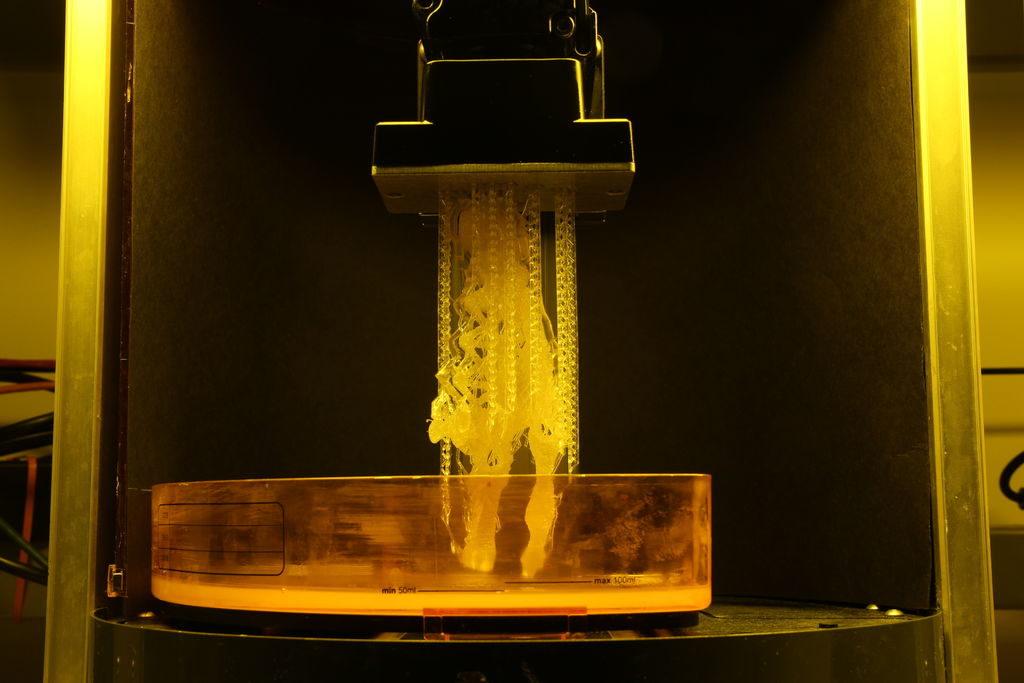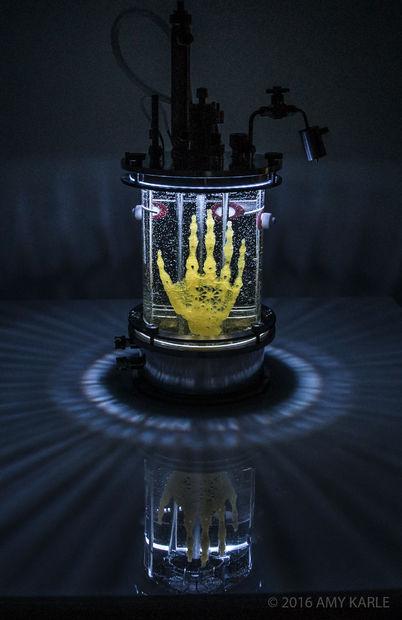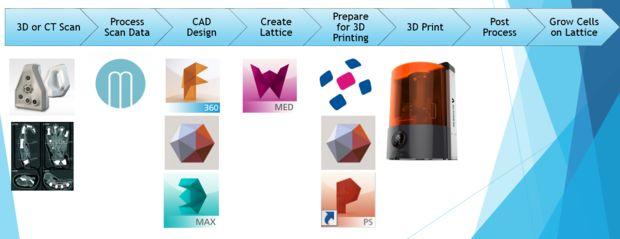 At the juncture between creative exploration and scientific technology lies the work of Amy Karle, who is the current Artist in Residence at Autodesk. The idea behind her work was to use live cells as the components of a sculptural form. By harnessing the natural functions of the cells, replication and growth, she uses them to build her sculpture around a scaffold that she has created. As she explained in her tutorial on Instructables:
At the juncture between creative exploration and scientific technology lies the work of Amy Karle, who is the current Artist in Residence at Autodesk. The idea behind her work was to use live cells as the components of a sculptural form. By harnessing the natural functions of the cells, replication and growth, she uses them to build her sculpture around a scaffold that she has created. As she explained in her tutorial on Instructables:
“I turned to synthetic biology and regenerative medicine and set out on a journey of creating artwork that could grow into form. Using CAD design and 3D printing, I created scaffolds to encourage cell growth into a certain from, a 3D printed framework that tissue can regenerate on.”
 The work has not only aroused interest in the arts and culture community, but also raised questions by those in the medical and pharmaceutical industries as to the possibilities present for such 3D printed structures to serve as scaffolding for cell growth for a variety of applications. Karle is not only interested in exploring the possibilities for her scaffolding but also in sharing what she has learned so far openly in the spirit of the open source movement. As such, she has posted a 12 step tutorial on Instructables including a sample file.
The work has not only aroused interest in the arts and culture community, but also raised questions by those in the medical and pharmaceutical industries as to the possibilities present for such 3D printed structures to serve as scaffolding for cell growth for a variety of applications. Karle is not only interested in exploring the possibilities for her scaffolding but also in sharing what she has learned so far openly in the spirit of the open source movement. As such, she has posted a 12 step tutorial on Instructables including a sample file.
Karle doesn’t create these things in the back corner of her garage nor did she just stumble upon the methods she uses. Instead, this project is the product of years of careful study and sterile maker lab space. After attending Alfred University and Cornell, she received degrees in Art & Design and in Philosophy and has been setting fire to the art and science world ever since. Her attraction to bone and cells as a medium and the hand as a form was described in her artist’s statement:
“I felt completely drawn to bone. Bone is the structure and foundation that supports our bodies and provides protection, it stores minerals and energy, produces blood cells, plays a vital role in protecting the body against infection, and enables us to move. What we done usually think of is that bone is a very dynamic organ that is constantly remodeling and changing shape to adapt to the daily forces placed upon it…As I was exploring regenerative medicine, I was studying bones, medical implant design and additive manufacturing. I have been making 3D printed artwork of many different kinds of bones, and have now turned my focus to the human hand.”
 Her interest has been and continues to be the makings and workings of human existence and her projects continually explore the connection between technology and the body. From examination of the relationships between consciousness and experience in terms of physical manifestation to the development of patents, servicemarks, and trademarks in medical and technology sectors, her work is attracting a great deal of attention from a wide audience. Not only has she received a Presidential Honor of Distinction, but she has also been awarded the Art Silver Key Award from the National Gallery of Art and the American Visions National Art Award.
Her interest has been and continues to be the makings and workings of human existence and her projects continually explore the connection between technology and the body. From examination of the relationships between consciousness and experience in terms of physical manifestation to the development of patents, servicemarks, and trademarks in medical and technology sectors, her work is attracting a great deal of attention from a wide audience. Not only has she received a Presidential Honor of Distinction, but she has also been awarded the Art Silver Key Award from the National Gallery of Art and the American Visions National Art Award.
In the meantime, if you are interested in doing your own experiments in the comfort of your own maker place, to create scaffolding all you’ll need is some scan data, ReMake, Fusion 360 and/or Meshmixer, Within Medical, Netfabb, and some non-toxic cell growth media. Karle makes her own mixture of 3D printable material using a a polyethylene (glycol) diacrylate (PEGDA) hydrogel and has attached a whitepaper with more information about the mixture on the resources page. When she is ready to print, she uses an Ember 3D printer.
 Once you have the scaffolding, you’ll need to get your hands on some cells which, it turns out, is not as difficult as I had thought. Karle prefers to use Mesenchymal stem cells (MSCs). Those cells are transferred to the scaffolding for growth and, in a supportive, nutrient-rich environment, will grow. Note to mad scientists (and stem cell phobic doomsayers) at no point is sentient life created and you will not be able to grow an evil army to do your bidding. I guess for that, we’ll still have to wait. Discuss further in the 3D Printed Scaffolding forum over at 3DPB.com.
Once you have the scaffolding, you’ll need to get your hands on some cells which, it turns out, is not as difficult as I had thought. Karle prefers to use Mesenchymal stem cells (MSCs). Those cells are transferred to the scaffolding for growth and, in a supportive, nutrient-rich environment, will grow. Note to mad scientists (and stem cell phobic doomsayers) at no point is sentient life created and you will not be able to grow an evil army to do your bidding. I guess for that, we’ll still have to wait. Discuss further in the 3D Printed Scaffolding forum over at 3DPB.com.
Subscribe to Our Email Newsletter
Stay up-to-date on all the latest news from the 3D printing industry and receive information and offers from third party vendors.
You May Also Like
Precision at the Microscale: UK Researchers Advance Medical Devices with BMF’s 3D Printing Tech
University of Nottingham researchers are using Boston Micro Fabrication‘s (BMF) 3D printing technology to develop medical devices that improve compatibility with human tissue. Funded by a UK grant, this project...
3D Printing Webinar and Event Roundup: April 21, 2024
It’s another busy week of webinars and events, starting with Hannover Messe in Germany and continuing with Metalcasting Congress, Chinaplas, TechBlick’s Innovation Festival, and more. Stratasys continues its advanced training...
3D Printing Webinar and Event Roundup: March 17, 2024
It’s another busy week of webinars and events, including SALMED 2024 and AM Forum in Berlin. Stratasys continues its in-person training and is offering two webinars, ASTM is holding a...
3D Printed Micro Antenna is 15% Smaller and 6X Lighter
Horizon Microtechnologies has achieved success in creating a high-frequency D-Band horn antenna through micro 3D printing. However, this achievement did not rely solely on 3D printing; it involved a combination...





























